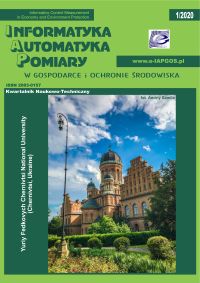ZASTOSOWANIE WSKAŹNIKA HURSTA W SIECI TELEKOMUNIKACYJNEJ DLA WYBORU ALGORYTMU STEROWANIA
##plugins.themes.bootstrap3.article.sidebar##
Open full text
Numer Tom 10 Nr 1 (2020)
-
ZASTOSOWANIE WSKAŹNIKA HURSTA W SIECI TELEKOMUNIKACYJNEJ DLA WYBORU ALGORYTMU STEROWANIA
Anton Vrublevskiy, Ivan Lesovoy, Gennadij Pylypenko4-7
-
SZYFRY BLOKOWE NA PODSTAWIE ODWRACALNYCH AUTOMATÓW KOMÓRKOWYCH
Yuliya Tanasyuk, Petro Burdeinyi8-11
-
URZĄDZENIE PRZEŁĄCZAJĄCE INTERWAŁ CZASOWY
Ruslan Politanskyi, Andrij Veryga12-15
-
ŚRODOWISKO KOMPATYBILNOŚCI ELEKTROMAGNETYCZNEJ ŚRODKÓW KOMUNIKACJI RADIOELEKTRONICZNEJ
Heorhii Rozorinov, Oleksandr Hres, Volodymyr Rusyn, Petro Shpatar16-19
-
GENEROWANIE SEKWENCJI LOSOWYCH O ZWIĘKSZONEJ SILE KRYPTOGRAFICZNEJ
Volodymyr Korchynskyi, Vitalii Kildishev, Oleksandr Riabukha, Oleksandr Berdnikov20-23
-
ZWIĘKSZENIE WYDAJNOŚCI ENERGETYCZNEJ SPRZĘTU RADIOWEGO W OPARCIU O STOSOWANIE MODULACJI PRZEZ ORTOGONALNE HARMONICZNE
Sergey Toliupa, Vladimir Nakonechnyi, Alexander Trush24-27
-
SYNTEZA ALGORYTMÓW BEZPIECZNEGO POSTĘPOWANIA W SYSTEMACH RADIOELEKTRONICZNYCH DO ZASTOSOWAŃ W SYTUACJACH KRYTYCZNYCH
Leonid Ozirkovskyy, Bohdan Volochiy, Mykhailo Zmysnyi, Oleksandr Shkiliuk28-31
-
METODA OCENY STRUKTURALNEJ NIEZAWODNOŚCI SIECI O NIEOKREŚLONEJ TOPOLOGII
Nina Kniazieva, Alexey Nenov, Irina Kolumba32-35
-
FOTODIODA OPARTA NA EPITAKSJALNYM FOSFORKU GALU O ZWIĘKSZONEJ WRAŻLIWOŚCI PRZY DŁUGOŚCI FALI 254 nm
Yurii Dobrovolsky, Volodymyr M. Lipka, Volodymyr V. Strebezhev, Yurii O. Sorokatyi, Mykola O. Sorokatyi, Olga P. Andreeva36-39
-
OKREŚLENIE POSTACI STRUKTURALNEJ ORAZ STABILNOŚCI POWIERZCHNI KRYSZTAŁU Cd1-xМnxTe KRYSTALIZOWANEJ LASEREM
Victor Strebezhev, Ivan Yuriychuk, Petro Fochuk, Sergiy Nichyi, Yuriy Dobrovolsky, Victoria Tkachuk, Mykola Sorokatyi, Yurii Sorokatyi40-43
-
TECHNOLOGIA I POMIARY MAGNETOOPORU W CIENKOWARSTWOWYCH STRUKTURACH FERROMAGNETYCZNYCH
Jakub Kisała, Karolina Czarnacka, Mateusz Gęca, Andrzej Kociubiński44-47
-
BADANIE WŁAŚCIWOŚCI PERMUTACJI PIKSELI W OPARCIU O ZDYSKRETYZOWANĄ MAPĘ STANDARDOWĄ
Serhii Haliuk, Oleh Krulikovskyi, Vitalii Vlasenko48-51
-
TECHNIKI ROZPOZNAWANIA TWARZY
Olexandr N. Romanyuk, Sergey I. Vyatkin, Sergii V. Pavlov, Pavlo I. Mykhaylov, Roman Y. Chekhmestruk, Ivan V. Perun52-57
-
BADANIE FILTRU KOŁMOGOROWA-WIENERA DLA CIĄGŁYCH PROCESÓW FRAKTALNYCH W OPARCIU O WIELOMIANY CZEBYSZEWA PIERWSZEGO RODZAJU
Vyacheslav Gorev, Alexander Gusev, Valerii Korniienko58-61
-
MODELOWANIE URZĄDZEŃ SPINTRONICZNYCH DO ZASTOSOWANIA W PAMIĘCI O DOSTĘPIE SWOBODNYM RAM
Ruslan Politanskyi, Maria Vistak, Andriy Veryga, Tetyana Ruda62-65
-
SPRZĘT I OPROGRAMOWANIE DO BADAŃ ELEMENTÓW ELEKTRONICZNYCH I CZUJNIKÓW
Gryhoriy Barylo, Oksana Boyko, Ihor Gelzynskyy, Roman Holyaka, Zenon Hotra, Tetyana Marusenkova, Mykola Khilchuk, Magdalena Michalska66-71
-
ODNAWIALNA ENERGIA ELEKTRYCZNA Z DWUTLENKU WĘGLA
Natalia Grigorieva, Viktor Shabaykovich, Larysa Gumeniuk, Pavlo Humeniuk, Lubov Dobrovolska, Dmitry Sobchuk72-76
-
NASYCENIE PROCESU ABSORPCJI PROMIENIOWANIA TERMICZNEGO W ATMOSFERYCZNYM DWUTLENKU WĘGLA
Jan Kubicki, Krzysztof Kopczyński, Jarosław Młyńczak77-81
-
KLASYFIKACJA WYNIKÓW WIELOWYMIAROWEJ MIKROSKOPII POLARYZACYJNEJ W TECHNOLOGII INTELIGENTNEGO MONITOROWANIA CHORÓB SERCA W MEDYCYNIE SĄDOWEJ
Oleg Vanchulyak, Serhii Golub, Mariia Talakh, Vyacheslav Gantyuk82-86
Archiwum
-
Tom 12 Nr 4
2022-12-30 16
-
Tom 12 Nr 3
2022-09-30 15
-
Tom 12 Nr 2
2022-06-30 16
-
Tom 12 Nr 1
2022-03-31 9
-
Tom 11 Nr 4
2021-12-20 15
-
Tom 11 Nr 3
2021-09-30 10
-
Tom 11 Nr 2
2021-06-30 11
-
Tom 11 Nr 1
2021-03-31 14
-
Tom 10 Nr 4
2020-12-20 16
-
Tom 10 Nr 3
2020-09-30 22
-
Tom 10 Nr 2
2020-06-30 16
-
Tom 10 Nr 1
2020-03-30 19
-
Tom 9 Nr 4
2019-12-16 20
-
Tom 9 Nr 3
2019-09-26 20
-
Tom 9 Nr 2
2019-06-21 16
-
Tom 9 Nr 1
2019-03-03 13
-
Tom 8 Nr 4
2018-12-16 16
-
Tom 8 Nr 3
2018-09-25 16
-
Tom 8 Nr 2
2018-05-30 18
-
Tom 8 Nr 1
2018-02-28 18
##plugins.themes.bootstrap3.article.main##
DOI
Authors
Abstrakt
Wykazano, że całki rozmyte (Sugeno i Shock) mają szczególne właściwości i są odpowiednie dla systemu rozmytego do zarządzania zasobami sieci telekomunikacyjnej. Zaproponowano formę wyboru metody obliczania współczynnika Hursta w systemie sterowania rozmytego dla zasobów sieci telekomunikacyjnych.
Słowa kluczowe:
Bibliografia
Bychkov Ye. D.: Prilozheniye teorii nechetkikh (FUZZY) mnozhestv v matematicheskikh modelyakh sistem svyazi. Izd-vo Omskoy Gos. Med. Akademii, Omsk 2000.
Dang T. D., Sonkoly В., Molnar S.: Fractal Analysis and Modelling of VoIP Traffic. NETWORKS-2004. Vienna. Austria. 2004, 95–104.
Dubois D., Prad H.: Fuzzy Sets and Systems: Theory and applications. Acad. Press, New York 1980.
Ghaderi M.: On the Relevance of Self-Similarity in Network Traffic Prediction. School of Computer Science, University of Waterloo, Waterloo 2003.
Ilnickis S.: Research of the Network Server in Self-Similar Traffic Environment. Scientific proceedings of Riga Tecnical University Telecommunication and Electronics. Computer Science l/2004, 78–81.
Karasaridis A., Hatzinakos D.: Network Heavy Traffic Modeling Using a-stable Self-Smilar Process. IEEE Transactin on Communications 49(7)/2001, 1203–1214. DOI: https://doi.org/10.1109/26.935161
Neyman V. I.: Novoye napravleniye v teorii teletrafika. Elektrosvyaz' 7/1998, 27–29.
Osin A. V.: Vliyaniye samopodobnosti rechevogo trafika na kachestvo obsluzhivaniya v telekommunikatsionnykh setyakh. PhD thesis, Moscow 2005.
Pospelov D. A.: Nechetkiye mnozhestva v modelyakh upravleniya i iskusstvennogo intellekta. Nauka, Moscow 1986.
Shelukhin O. I. (red.): Fraktal'nyye protsessy v telekommunikatsiyakh. Radiotekhnika, Moscow 2003.
Sugeno M.: Fuzzy measures and fuzzy integrals: a survey. Fuzzy automata and decision processes. North-Holland Publishning Company, Amsterdam 1977, 89–102.
Tsybakov B. S., Georganas N. D.: Self-Similar Processes in Communications Networks. IEEE Trans. on Information Theory 44(5)/1998, 1713–1725. DOI: https://doi.org/10.1109/18.705538
##plugins.themes.bootstrap3.article.details##
Abstract views: 345
Licencja

Utwór dostępny jest na licencji Creative Commons Uznanie autorstwa – Na tych samych warunkach 4.0 Miedzynarodowe.






